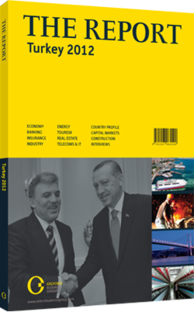OBG talks to Martin Spurling, CEO, HSBC Turkey; Adnan Bali, CEO, İş Bankası; and Hüseyin Aydın, General Manager, Ziraat Bankası

Interview: Martin Spurling, Adnan Bali Hüseyin Aydın
The Central Bank of the Republic of Turkey (CBRT) implemented unconventional policies in 2011, lowering the interest rate but raising reserve and capital requirements. How did this affect banks?
MARTIN SPURLING: Some of the central bank’s more “unorthodox” policies can make it more difficult for banks to plan for the period ahead, as these make funding costs more volatile and unpredictable. This is not unusual, however, for many markets, and look at where the central bank has gotten us to today – these policies have proved to help Turkey achieve a stronger economic performance and are proving successful in our view. Most bankers will tell you that stricter regulations create a more challenging operating environment for banks. However, we are the first to acknowledge that Turkey’s regulators and public authorities have worked very well together to create a positive environment for sustainable growth. They were doing really well and when in early 2011 the eurozone crisis kicked in they reacted very fast. That is one of the reasons why we believe in Turkey, and we want to grow here – the ability of local businesses and the economy to bounce back quickly.
HUSEYIN AYDIN: The central bank uses a mix of tools that gives the opportunity to follow both expansionary and tightening monetary policies efficiently and effectively when needed. As of early 2012, the weight of the monetary policy rate in the policy mix has decreased compared to other instruments, so the interest rate corridor and foreign reserve management have become more prominent. The policy mix has increased the cost of funding for the banking sector, which has hurt its bottom line. However, the current monetary policy stance is expected to continue until the CBRT’s goal of price and financial stability is achieved. Regarding capital adequacy rates, high levels of capital immunised the sector against the kind of crises that have been seen in recent years. Capital adequacy regulation does not create difficulty in bank management, rather it protects the sector.
ADNAN BALİ:The quality and stability of banking regulation has played a huge role in the positive performance of the sector. I think this context needs to inform the recent debate about how capital and liquidity requirements limit the abilities of banks in Turkey, especially in terms of lending, which may lead to high credit spreads and less available credit. These constraints may also slow growth, but we should also take into consideration the current global crisis, and the frequency and severity of crises in the financial sector. In that particularly context, there is a trade-off between stricter regulations and their impact on the financial sector, on the one hand, and the security to remain profitable during crisis, on the other. The long-term benefits of the regulations can out-weigh the short-terms costs, in that sense.
The current account deficit doubled between the third quarters of 2010 and 2011. Has this affected your confidence in the authorities?
AYDIN: It is more appropriate to discuss the current account balance, rather than the deficit, because then we can examine the context to see if a balance is being achieved. For Turkey, just like other emerging economies that have few resources and a high savings deficit, the current account deficit is generally the major engine of growth. Turkey imports investment goods and energy to increase future production capacity. The important question is how the deficit is financed. Monetary and fiscal policies strive to finance the gap with foreign direct investment flows. Our current account deficit doubled during 2011, even though our growth rate was among the best in the world. The goal is to ensure sustainable growth. Monetary and fiscal authorities have put this issue at the top of the agenda. Also, the CBRT has comfortable foreign currency reserves, compared with short-term FX debt and average monthly import figures, so the deficit is under control.
BALİ: We are not in the same position we were in the mid-1990s, the economy is rapidly expanding and it needs energy, which means significant imports. The most important issue here is the fragility of the current economic system, which needs to be supported by active commerce. This, combined with the recent economic measures, will help us eventually to see improvements in terms of the current-account-to-GPD ratio. It is important to note that we have successfully changed the composition of the export base as well, diversifying away from European markets such that their share accounts for just 42% of total exports. Our exports to North African, Middle Eastern and other countries have expanded. This is providing an opportunity for balance, in that sense Turkey can offset the negative impact of the contraction in the eurozone and maintain strong inflows to help finance the deficit.
SPURLING: If you look at historical examples of countries where the current account deficit reached 10% or more of GDP for a long time, we see that in some cases it triggered a foreign exchange crisis, which then turned into a wider economic crisis, followed by a contraction in the economy. Turkey is a country that is reliant on a significant amount of foreign financing for economic growth. The share of foreign investors in Istanbul Stock Exchange is high and in the past, Turkey witnessed fluctuations in short-term capital inflows. Moreover, energy is one of the country’s biggest imports and so a rise in the price of oil negatively impacts the current account balance. The government is very aware of this, however, and we are pleased to see proactive management of this challenge.
How has growth in the provision of electronic banking services changed the sector?
BALİ: We have well-developed, secure, user-friendly financial services networks that provide a diverse range of financial transactions. The average person on the street can invest in government bonds through an ATM or buy securities through internet banking. These are new applications, and I do not think there are similar examples in other countries. In our case, about 77% of total transactions are made through the non-branch channels, so it is very much a business climate in which convenience and service are driving customer behaviour. However, all of these services have made for a much more competitive sector, with customer convenience increasingly the primary focus. Service is essential now.
SPURLING: The banking sector was one of the key areas of the economy that was directly affected by the technological developments of the past two decades in Turkey. Leaving aside advancements in internal banking systems, the main technological evolution took place in customer-facing channels, especially online banking. Most banking customers enjoy 24/7 service access, instead of travelling to a nearby branch. And, on the flip side, this change created a cost reduction opportunity for the banks. This win-win situation generated a new facet of competition for the banking industry, namely online and mobile banking. To be competitive in this new field, Turkish banks have been developing innovative products and services, improving their online and mobile customer value propositions and increasing investments in IT. According to the banking association, retail internet banking users in Turkey increased by 162% in the past five years. Based on recent economic and demographic research, most increases in the bankable population are expected to come from young internet users. This explains the shift in competition towards electronic banking. AYDIN: As a general trend, the banking sector has been confronted with narrowing net interest margins due to competition in the market and the CBRT’s unorthodox policy. All of the banks are attempting to propose value to their customers through the right distribution channels in timely and effective ways. It is about increasing customer loyalty. Internet banking is gaining more importance, with the number of customers growing by 23% in 2011. Similarly, during that period, total financial and investment transactions through this channel increased by 60%. There is no doubt the banks that invest more in electronic banking will be more competitive in the short to medium term. Given the decreasing average age of customers, Turkish banks need to provide them better-designed relations management systems.
You have reached the limit of premium articles you can view for free.
Choose from the options below to purchase print or digital editions of our Reports. You can also purchase a website subscription giving you unlimited access to all of our Reports online for 12 months.
If you have already purchased this Report or have a website subscription, please login to continue.

